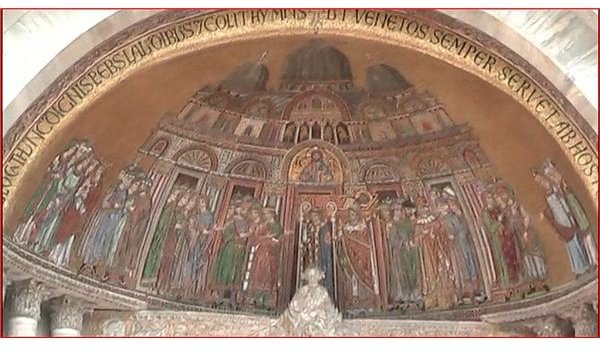Discovering Medieval Art: Gothic, Romanesque, and Byzantine Art
Background of Medieval Art
The Middle Ages was a time period that lasted from the 5th century to the end of the 15th century in Europe. During this time, several different art styles emerged that would allow artists to rethink traditions and push forward with new styles. For example, before the Byzantine period, many artists engaged in Christian iconography. Artists would often represent key religious figures such as Jesus Christ or the Virgin Mary to represent their status in Christendom. With this background in mind, medieval art would evolve steadily by rejecting and combining certain styles. For example, Christian iconography would become a stable style in the Byzantine, Romanesque, and Gothic styles; however, it would be represented in a fresh method in each style. Although art during the Middle Ages is a bit broad, these three styles represented the artistic and religious ideology of medieval Europe.
Byzantine Art
[caption id="" align=“aligncenter” width=“600”]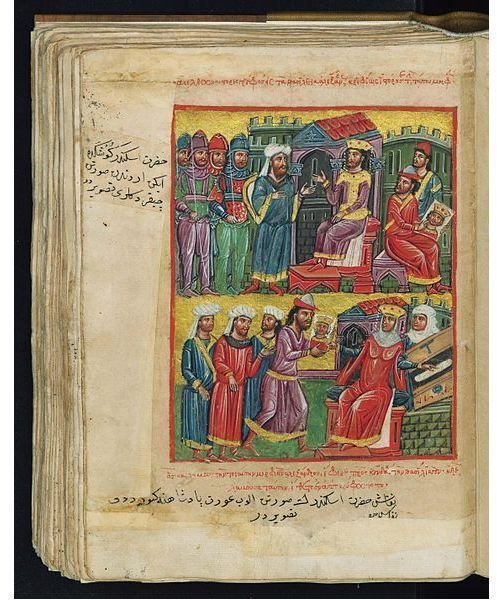 Byzantine Illuminated Manuscript of Alexander the Great[/caption]
Byzantine Illuminated Manuscript of Alexander the Great[/caption]
The first major style to emerge was the Byzantine style which lasted throughout the entire Middle Ages. This style is attributed to the Byzantine Empire which was the western part of the Roman Empire. When the Roman Empire collapsed in 476, the Byzantine Empire continued to thrive until its fall under Turkish hands in 1453. The majority of Byzantine art is concerned with Christian religious expressions that are often conveyed in churches. Often, many of these expressions were controlled by the church’s rigid tradition which wanted to emphasize Christian theology. In this respect, Byzantine architecture, paintings, and illuminated manuscripts mirrored this perspective.
[caption id="" align=“aligncenter” width=“600”]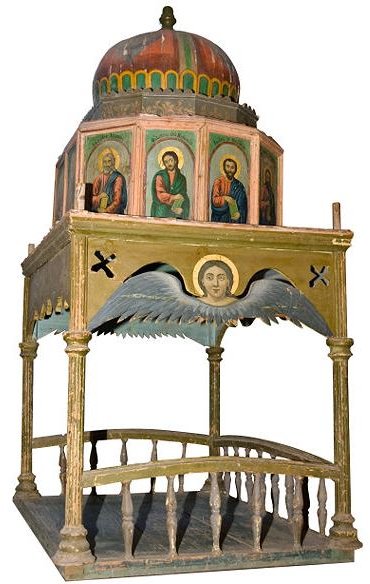 Example of Byzantine Architecture[/caption]
Example of Byzantine Architecture[/caption]
The first example is Byzantine architecture which featured large domes and vaults that would come to represent the order of the universe. For example, an iconographic image of God would be represented in the interior ceiling followed by lesser beings such as angels and saints which were represented below God. These depictions were often represented in frescoes and mosaics meant to depict the perfect order of the universe. Frescoes and mosaics were often displayed one-dimensionally and would represent religious figures that had solemn gazes to imply respect and tradition. Essentially, religious artists wished to emphasize these figures spiritually rather than physically modeling them from three-dimensional perspectives. Byzantine artists also participated in creating illuminated manuscripts which were books or documents that were decorated with lavish Byzantine materials. For example, many important Bibles were often made into illuminated manuscripts and had special covers, embroidered pages, and gold linings. In terms of influence, the Byzantine art style spread to Italy where it would gain significance during the Renaissance. Other nations such as Russia would also use these styles in Eastern Orthodox churches and would remain unchanged for centuries. The Byzantine art style would become a foundation for the future medieval art styles.
Romanesque Art

Unlike Byzantine art which developed in the eastern part of the Roman Empire, Romanesque art developed in the western part of the Roman Empire. The Catholic Church would play a key role in developing this style that would become prevalent from around 1000 to 1150 and soon become eclipsed into the Gothic art style. Romanesque art can be described as a fusion of several styles such as Roman, Byzantine, and other Germanic styles. In this retrospect, many churches adopted the use of the Roman semicircle arch which would be used in countless ways such as with the design of windows, doors, and even corridors. This design allowed artists to create vaults allowing more space for congregations as well as church officials. In addition to architecture, sculptures were also prevalent during this medieval art style. Stone sculptures were often created to represent biblical history and church doctrine. They were also often erected on church pillars and doors as well as in other places. Like Byzantine art, these sculptures were often transcendent to represent the spiritual nature of Christian theology.
[caption id="" align=“aligncenter” width=“600”]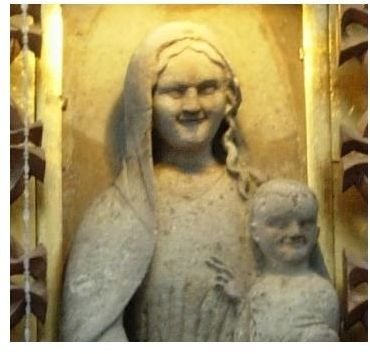 Romanesque Sculpture[/caption]
Romanesque Sculpture[/caption]
What about paintings during the Romanesque period? Like sculptures, murals were often erected onto church walls and pillars and closely represented sculptures in their style. In addition, artists continued the tradition of illuminated manuscripts that became very popular and lavish. Even with these forms of art, the Romanesque style would eventually evolve into the Gothic art style.
Gothic Art
[caption id="" align=“aligncenter” width=“600”]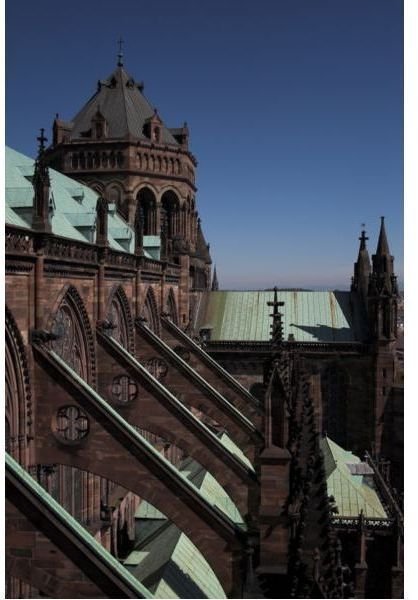 Flying Buttress of Notre Dame de Strasbourg[/caption]
Flying Buttress of Notre Dame de Strasbourg[/caption]
The last medieval art style was the Gothic art style which lasted from the 12th century up to the 16th century. The Gothic style revolutionized architecture by innovating structural designs such as the adoption of “ribbed vaults” which were intersecting roof sections that allowed more stability as well as being lighter than previous designs. Ribbed vaults gave rise to “flying buttresses” which were angled supports that could be enhanced with decorated “pinnacles” and allow more support for the structure. With these two innovations, buildings could construct lighter and taller buildings that ever before. Although Gothic architecture would travel through several stages, Gothic sculptures would also follow the same experience. For example, Gothic sculptures became associated with Gothic architecture and were similar to the Romanesque period as to where they would be located. Even with these similarities, Gothic sculptures evolved into being more realistic and lifelike rather than the stiff appearance of Romanesque sculptures. These sculptures became closely related with medieval cathedrals and often had specific styles within themselves. Last but not least are Gothic paintings. Like sculptures, paintings became more lifelike and colorized rather than their Byzantine and
[caption id="" align=“aligncenter” width=“600”] Late gothic painting, Kotor Sv. Tryphon[/caption]
Late gothic painting, Kotor Sv. Tryphon[/caption]
Romanesque predecessors which focused on a transcendent style. Paintings also became more secular with artists rendering non-religious topics such as chivalric themes that were often compiled in illuminated manuscripts. In the 15th century, printed paintings replaced illuminated manuscripts and gave rise to an increased awareness of naturalism and realism rather than the stiff, transcendent paintings of the previous periods.
References
Sources:
- Encyclopedia Britannica. “Byzantine Art.”
- Encyclopedia Britannica. “Gothic Art.”
- Encyclopedia Britannica. “Romanesque Art.”
Images:
- Anonymous. “Byzantine Greek Alexander Manuscript.”
- Romanesque church in Czerwińsk nad Wisłą.
- Fabienkhan. “Konya Archelogical Museum-Byzantine Art.”
- Halun, Jakub. “Wislica Madonna.”
- ignis. “Church Notre Dame of Strasbourg.”
- Orjen. “Late Gothic Painting St. Kovor Tryphon.”
This post is part of the series: Medieval Life
This series provides social and cultural aspects of medieval Europe.
